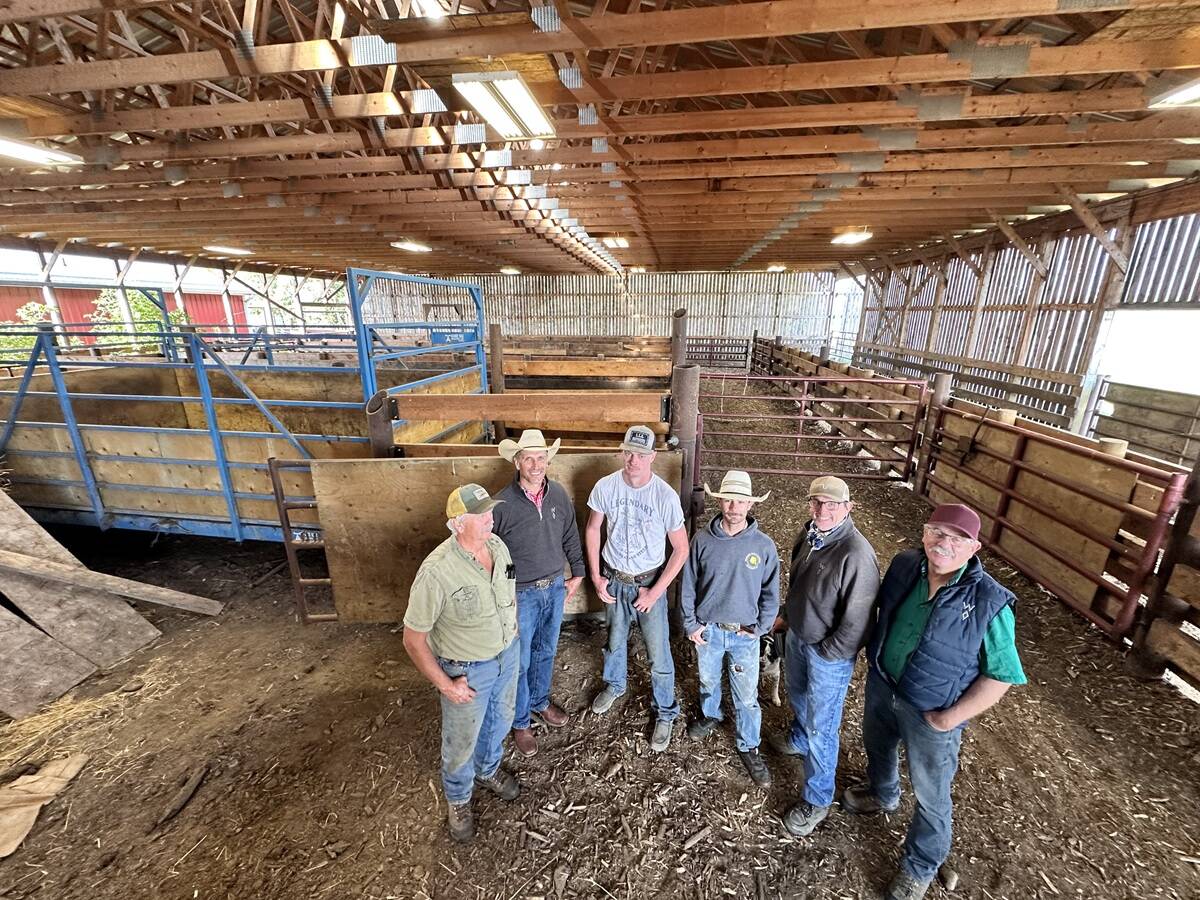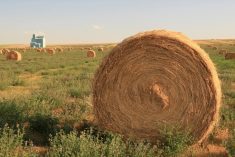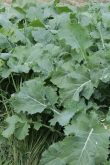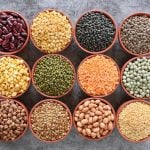Research over the years in various regions has looked at the potential and advantages of grass-legume mixtures for pasture. A diversified pasture stand allows for different plants to thrive in different conditions, adding drought resistance. Legumes have a deep tap root and can penetrate deeper into the soil profile where there’s more moisture. Pastures with few or no legumes run the risk of depletion earlier in the grazing season and the producer must feed hay earlier. Without legumes you may have less pasture and a lower quality of forage.
Read Also

Farm families work together to graze cropland with cattle in the fall
These Alberta farm families have separate operations, but work together to manage their land
Karin Lindquist, a forage beef specialist from Stettler, Alta., says the ideal pasture will depend on the goals of the producer as well as location and soil type. This will affect the selection of forage species of grass and legumes.
Linquist, beef and forage specialist Grant Lastiwka and economist Anatoliy Oginskyy are part of an Alberta team doing studies with sainfoin in grass-legume mixes over the past five-plus years. A two-year high legume pasture project was just completed. “The project was built around a number of objectives but based on a comment by rancher Doug Wray during a presentation. He wondered what an ideal pasture would look like, if you seeded it correctly and then managed it properly,” says Lastiwka.
“We thought about the needs of the soil below, and the need for a highly productive pasture above ground — looking at profit per acre. Our 12 sites, and some of the experienced high-legume grazing mentors who provided their pasture and financial records to be analyzed by Anatoliy Oginskyy, were the subject of workshops we held during the summer of 2016 all across Alberta — from High River (partnering with Applied Research and Extension Associations in Alberta and the Peace River Forage Association of B.C.) to Fort Vermilion,” he says.
The grazing mentors presented at 10 workshops in 2016, and some additional workshops in 2017 and 2018. “The idea is to try to help people realize the potential opportunity of having more legumes in a pasture — and the need to generate more profit per acre from pastures.
“Stocking rate is highly correlated to profit, but we can only stock sustainably if we do not exceed carrying capacity. We must have high forage productivity to allow for continual regeneration of profit, and keep adding to soil wealth below the ground,” he says.
“For many years we’ve tried to encourage producers to use more legumes in their grazing systems. It’s been a challenge. The first time was in 1996, with the first Western Canadian Grazing Conference. Speakers like Wyett Swanson, Paul McCaughey and Jim Gerrish talked about high-quality, high-yielding pastures. Currently, our local high-legume grazers are sharing their experiences and what they’ve learned.”
The team is looking at how much legume you should have in a pasture and how long you can expect it to stay without having to reseed.
“This depends on a number of things, but we are focusing on the management of establishment and successfully grazing what we seeded. If a stand is managed for high production, it will have longer rest periods between grazing incidents and shorter grazing periods. It will produce higher quantity and suitable quality, and some of the legumes can set seed and reseed themselves,” notes Lastiwka.
“The producer should aim for at least a 60-40 mix, 60 per cent legume, 40 per cent grass, for optimum productivity, nutrient recycling, animal performance and less risk for bloat,” says Lindquist.
“Some people prefer a higher rate, like 70-30, especially if they utilize two species of legume in a stand and want higher performance in their animals. It’s hard to achieve a 50-50 ratio because you’ll never get it exactly half and half,” she says. Species competition, management practices and animal preferences influence composition of the stand and it may change over time.
“Unfortunately, when people hear the word ‘legume’ they may only think about alfalfa and bloat, but there are many non-bloating options,” she says. With the 60-40 ratio you can have two or more legumes rather than just one, especially if bloat is a concern.
“For example, a mix of 20 per cent sainfoin, 40 per cent alfalfa and 40 per cent grass can reduce bloat potential by 98 per cent. Alfalfa is the most commonly used legume because it’s so quick to establish and highly competitive with grasses, but there are many varieties to choose from, including a ‘no bloat’ variety called AC Haymaker that reduces bloat potential by 80 per cent. Some of the other legumes are slower to establish unless they have perfect conditions; it may take two or three years for cicer milkvetch to finally come into the stand after seeding, and it can test your patience!” Similarly, birdsfoot trefoil and some clovers cannot be seeded in a cover crop because of poor competitiveness.
Most varieties of sainfoin were hard to establish in a mix because they don’t compete well with alfalfa and grasses.
“Fortunately, a new sainfoin variety called AC Mountainview was developed by Dr. Surya Achurya from the Ag-Canada Lethbridge Research Station. This cultivar was ideal to use as part of our project,” says Lindquist.

Longevity of legumes is often a concern but can be addressed by periodically giving the legumes enough time to set seed. If you don’t graze off too much, and allow enough rest and recovery so plants can reach full maturity and drop seed, the stand will be self-perpetuating. Legumes are more sensitive to grazing than grasses and need sufficient leaf area for regrowth. Using rotational grazing rather than season-long grazing is best to ensure legumes stay in the stand for more than just a few years.
“Having a rest period of at least four to six weeks is recommended, but for seed set and reseeding to occur, that recovery period should be longer — several months to a year, if necessary. Allowing for seed set is very important, especially for the shorter-lived legumes like some of the clovers. Then new plants can come in when the old ones begin to die out, and the legumes can stay in the stand for many years,” she explains.
One producer in southern Alberta has had sainfoin in a stand for 20 years. This stand persists because he has allowed it to set seed every couple of years, and the cattle tromp the seed into the ground for natural replanting.
If producers can get sainfoin plants established within the first three years, self-seeding works well. Seeding rate and preparation of seedbed is important to establish any small forage seed. “The fact that the new sainfoin varieties have larger seed size tells us you need a little more volume of seed to have the same amount of plants,” says Lastiwka.
“The biggest drawback for sainfoin is the seed cost, per acre, to plant it,” says Bart Lardner, a beef and forage research scientist at the University of Saskatchewan. “It is a large-seeded legume compared to alfalfa, so seed costs are a detriment. It costs about three times as much as alfalfa seed; right now alfalfa is about $35 an acre for seed, and it’s about $90 an acre for sainfoin,” he says.
“We have some ongoing research here with our forage breeder Dr. Bill Biligetu at the University of Saskatchewan and he’s looking at trying to reduce seed size, to get the cost down to where it’s more competitive with alfalfa,” says Lardner.
It’s important to properly prepare the ground before seeding sainfoin. “You need to make the seedbed very firm before seeding,” says Lastiwka. “I like using a coil packer and a set of harrows, or rolling the soil before any seeding method is used,” he explains.
“The challenge is that when we try to seed with drills or some precise system to place seed in the ground, it’s difficult to get the right seeding rate. Most people don’t seed forages very often and it’s easy to make mistakes. But if you have the ground firm enough you can’t make the mistake of seeding too deep. This is crucial — to have just a quarter- to half-inch seed depth,” he says.
“Using any system where it’s on top of the surface (like a Valmar or blowing it on), more seed is being left on the surface, necessitating a higher seeding rate. With higher-cost legume seed, this can be a concern. In drier areas or dry years, this method also doesn’t work as well — with more failed stands. Using more seed will seldom make up for doing it wrong,” says Lastiwka.
Lastiwka seeded his own pastures with cicer milkvetch, yellow-blossomed hardy alfalfa, two types of sainfoin, another type of alfalfa that’s a creeper, birdsfoot trefoil, and alsike clover as the legumes. “I seeded everything together and in the low areas of the field I got more birdsfoot trefoil and alsike clover. In the higher, drier areas I got more alfalfa and sainfoin. Now it’s up to me to try to manage the pasture,” he says.
“We need some grass in those stands because we need fine soil roots nearer the surface, and sod growth with litter to cover and protect the soil surface. Grasses are a combination of energy and crude protein, more in balance than a high crude protein legume which may not be as balanced in energy,” says Lastiwka. Often cattle prefer the grass to the legume.
Winter hardiness is another important factor in selecting legumes for a pasture mix.
“Cicer milkvetch is very winter hardy and can last a long time once it’s established, even in dry years,” says Lindquist.
“Alfalfa has good winter hardiness, as long as it gets about 45 to 60 days of rest before the first killing frost so that its energy reserves are replenished. After it is dormant it can be grazed again.”
“Birdsfoot trefoil and most clovers won’t last as long in a stand unless you allow them to go to seed. Birdsfoot trefoil typically doesn’t do so well here in Western Canada as forage, but in most of Eastern Canada it fares much better. It can grow in a variety of conditions and the winters are usually mild, with better snow cover to protect it. In our region, we don’t always have enough snow,” she explains.
Alfalfa generally does best with some snow cover for protection.
“All legumes face increased risk for winterkill if the plants have not been given enough time to replenish energy stores in their roots before killing frost. Once they go dormant, most species can be fall or winter-grazed,” says Lindquist.
The grasses
There are several grass species to choose from but it’s important to select grasses that are not highly competitive.
Meadow brome is a good choice for areas with higher moisture because it spreads at a much slower pace than smooth brome and is not as aggressive.
“Smooth brome is especially competitive because it is sod-forming and spreads by underground roots called rhizomes. It will take over the stand eventually, and you’ll have nothing left but grass,” explains Lindquist.
Orchard grass or timothy works for higher-moisture locations, and is recommended for a grass-legume mix. These grasses spread primarily by seed dispersal.
For drier areas, crested wheatgrass can be a good forage to mix with legumes, especially sainfoin, that also likes drier locations.
“Tall fescue can be planted with legumes; it is not as aggressive as Kentucky bluegrass,” says Lindquist.
For longevity, any grass species will last longer if you allow it enough rest to go to seed now and then, just like the legumes.
“They both need enough leaf area to recover, but grasses also need the rest to recover lost root energy reserves, to grow new shoots and new roots. A short-duration rotational grazing program, rather than season-long grazing, is best. All forage plants need sufficient rest, and they also need the hoof impact and manure from the grazing animals to maintain a healthy mixed-species stand,” she says.
Timing is always a factor in rotational grazing. If the animals come back to a pasture too soon, plants will suffer. Recovery periods can vary from two or three weeks in the spring, to many months, depending on the area and how dry it is. Some pastures may only withstand grazing once or twice a year. For some native grasses in dry regions, once a year is all they can handle; they need a year to regrow.
Drought protection
Legumes are part of the natural balance and biodiversity found in native pastures.
Lastiwka says Dr. Mike Schellenberg, a rangeland plant ecologist with Agriculture and Agri-Food Canada at Swift Current has estimated original prairie native grasslands were roughly 10 per cent legumes in the form of buffalo beans, vetches, pea vine, clovers, wolf willow, lupine and others. It was a self-sustaining system that added nitrogen to the soil.
“We are looking at the ability of legumes to add nitrogen fertility to increase the productivity of the whole system. During a drought, in the short term, nitrogen is more important than water. We know the importance of water, but we can also see on bale-grazed ground that forage grows very well on areas where the bales were, even when it’s dry. The ability of a pasture stand to be more drought-resistant with a legume is partly because of the contribution of nitrogen to the system, but also the root going down into a deeper part of the soil,” he says.
“Mike Schellenberg says legumes lift water from deeper in the soil, and then through root exudates leak some of it for grasses to take up. The thing about multi-functional species groups with different attributes is the ability of legumes to avoid the effects of drought. We want to put together more plants, with different traits, so they can work together and overall have better ability to withstand variable weather. Also, legumes hold their quality and contribute yield and protein — helping alleviate the shortfall of protein later in the season for grazing,” Lastiwka says.
“If I have a very old pasture, its limitation for productivity is probably most often going to be water and nitrogen and I need a more active nutrient cycle so my production will be higher. I believe I can capture more carbon with a legume-grass pasture that has a higher yield than with a non-fertilized straight grass pasture. Soil organic matter contains approximately 58 per cent soil organic carbon,” he explains.
“For every percent of organic matter in the soil, we can hold about 20,000 more gallons of water per acre. A study of soils in Michigan demonstrated potential crop yield increases of 12 per cent for every one per cent increase in soil organic matter.
“Dale Kaliel, an Alberta agriculture economist, surveyed Alberta cow-calf producers from 2004 to 2010, looking at grass pastures, legume pastures, native pastures, and bush pastures. When he compared grass-legume pastures to tame grass pasture, he had on average 25 per cent more grazing days and 31 per cent more profit per acre, which included accounting for the seeding and establishment.”
In later surveys, Kaliel and Anatoliy Oginskyy found there were about 57 per cent more grazing days on average and 92 per cent more profit per acre on the grass-legume pastures compared to a tame grass pasture.
Ranchers are always trying to get more grazing days or find more pasture. “It may come down to ‘buying’ another ranch on our own farm, increasing production on the acres we already have. Last year, when I ran out of grass, I had legume-grass for my cattle to go to. When none of my other grass was ready I was able to graze my higher-legume grass pasture,” he says.
















